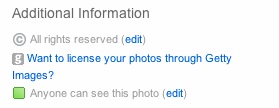Last week news broke that Getty Images was making the majority of its collection available for editorial and acedemic embedding as long as they can append a footer at the bottom of the picture. The Verge reported that according to Craig Peters, a business development exec at Getty Images the ship sailed long ago as far as trying to prevent unauthorized use of their images online (story here) and their “content was everywhere already”.
Peter Krogh of The DAM Book has a different take on the situation. He speculates that the Carlyle Group, the private equity firm that has majority ownership of Getty is looking to cash out before a 1.2 billion dollar loan comes due in 2016 and given that Getty’s 2011 revenue was $900 million their profit is likely a small fraction of that and so they need to do something quickly to increase the value of the company.
Peter goes on to theorize that the whole embedding business is about gathering information which I agree can be more valuable than money to investors. You should read his entire post here: http://thedambook.com/getty-did-what
You only have to look the Facebook purchases of Instagram and WhatsApp or the stock price of Twitter to understand that users are more valuable than revenue. So I think Getty is going to get on the user bandwagon by allowing free use of their images. What’s crazy about everyone getting on the user bandwagon is they all have the same plan to make money in the end: advertising. I think some simple math will prove that adding up all the minutes spent on an application times the current ad rates does not equal the valuation all these companies supposedly have. Getty is very late to a game of chicken with companies that have a tiny fraction of the overhead. All signs point to a writedown for the Carlyle Group in 2016.





